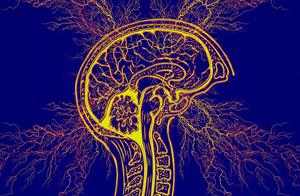Neuroscience For Kids
Migraine vs Headache
By Kate DiNucci, Neuroscience for Kids Guest Writer
June 29, 2023
 Have you ever had a terrible pain in your brain that just can't seem
to go away? Headaches are one of the most common causes of pain, with a
whopping 96% of the population having experienced a headache in their
lifetime. But only 10% of the population report having had a migraine.
Have you ever had a terrible pain in your brain that just can't seem
to go away? Headaches are one of the most common causes of pain, with a
whopping 96% of the population having experienced a headache in their
lifetime. But only 10% of the population report having had a migraine.
What is the difference between a headache and a migraine?
Headache
- Pain occurring anywhere in the head; pain can be localized or over a large area
- Pain can manifest in a variety of ways from acute to dull, and come on quickly or slowly
- Symptoms can be very brief, lasting an hour, or prolonged, lasting several days
Migraine
- Severe localized headache; generally an intense radiating pain
- Symptoms may include nausea, vomiting, and sensitivity to sensory input such as light, sound, touch or smell
- Can last for hours to days and the pain can be so severe that it interferes with daily activities
- Can sometimes be preceded by an "aura." An aura is a change in vision or altered sensation including numbness or tingling, or difficulty with speech
What is happening in the brain when a headache or migraine occurs?

Even though it may feel as though the pain is coming from the very tissue of your brain, the brain actually has no pain receptors! While there are other cells in your head that have pain receptors, such as those near blood vessels, the primary cause for headaches is not usually occurring in the brain at all. Generally, headaches are caused by enlarged blood vessels, muscle tension, or stress. When this happens, the nerves surrounding blood vessels send signals to the brain to communicate the problem and the brain produces a pain response.
The exact cause of migraines is still being researched but current theories suggest that fluctuating levels of neurotransmitters, such as serotonin or estrogen, may play a role. Serotonin and estrogen are involved with intercellular communication but research suggests they can also cause blood vessels to constrict and dilate. Changes in brain activity and cell communication can alter neurotransmitter levels that causese blood vessels to constrict. This change in the size of blood vessels could cause or contribute to migraine pain.
Should I be concerned if I have a headache or migraine?

A headache that is not a symptom of a deeper underlying problem is referred to as a primary Headache; a secondary headache indicates an underlying problem or condition. It is estimated that 18% of all headaches are secondary headaches. A secondary headache could be caused by dehydration or improper medication usage. One type of secondary headache called a thunderclap headache can be particularly concerning. A thunderclap headache comes on suddenly and is extremely painful, and it can be a sign of a brain injury. The majority of headaches will go away with time or at-home remedies.
Migraines generally are not indicative of an underlying problem, but they can interfere with daily life. Migraine treatments that can improve the quality of life include taking preventative medications or a rescue medication that is taken during an active migraine attack to lessen the symptoms.
Ultimately, headaches and migraines are common and generally not something to be overly concerned about. Repeating headaches or migraines can be related to high levels of stress or other lifestyle choices, so it is important to be mindful of how our behavior affects our bodies.
References:
- Headache - Mayo Clinic
- Migraine - Mayo Clinic
- Headaches - Cleveland Clinic
- Understanding Headaches and Migraines
- Headache Pain
- How a Migraine Happens
- Red and orange flags for secondary headaches in clinical practice
Copyright © 1996-2023, Eric H. Chudler All Rights Reserved.